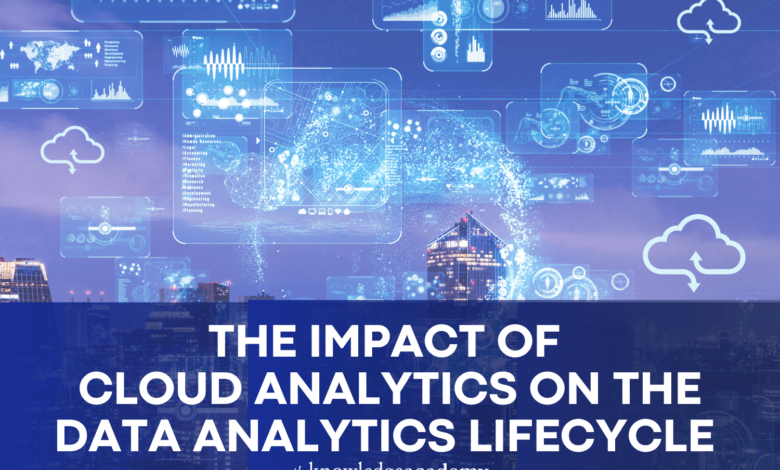The Impact of Cloud Analytics on the Data Analytics Lifecycle

Did you know that by 2025, the global cloud computing market will surpass $800 billion? This incredible figure underlines the tremendous spread and acceptance of cloud technologies in many different sectors. One area that is experiencing notable change as companies keep moving their data and apps to the cloud is the Data Analytics Lifecycle.
Data Analytics Certification Programmes increasingly align with these evolving needs, preparing professionals to leverage cloud analytics effectively. But what is cloud analytics, and how is it changing our approach to data? Let’s discuss this concept here.
Table Of Contents
- What is Cloud Analytics?
- Impact in Phase 1: Data Collection
- Impact in Phase 2: Data Storage
- Impact in Phase 3: Data Processing
- Impact in Phase 4: Data Analysis
- Impact in Phase 5: Data Visualisation and Reporting
- Conclusion
What is Cloud Analytics?
In cloud computing, cloud analytics is the application of analytic tools and approaches. This entails processing, storing, and analysing enormous volumes of data, utilising scalable cloud services to offer insights guiding corporate decisions. Cloud platforms for analytics, such as AWS, Google Cloud, and Microsoft Azure, provide a suite of tools allowing companies to maximise data accessible from the constraints of conventional on-site infrastructure.
Impact in Phase 1: Data Collection
Traditional data collection consisted of compiling data from several sources and keeping it on physical servers. Apart from cost, this approach was limited by accessibility and storage capacity. Now, we have cloud analytics.
Cloud analytics has made data collection more scalable and efficient. These days, companies can keep data in the cloud after gathering it from many sources, including transactional databases, social media platforms, and IoT devices. With almost limitless storage capacity offered by cloud services, companies may compile and save copious amounts of data without worrying about running out.
Furthermore, cloud-based data collection instruments can automatically link with several data sources. This interface makes real-time data collection more accessible, so companies can be guaranteed to have current data for analysis.
Impact in Phase 2: Data Storage
Conventional data storage options included configuring and maintaining physical servers, which may be expensive and complicated. With scalable and flexible storage choices, cloud analytics transforms this step.
Safe, scalable, reasonably priced storage options abound from cloud storage providers, including Amazon S3, Google Cloud Storage, and Azure Blob Storage. These services let companies keep enormous volumes of data at a fraction of the cost of conventional storage systems. Furthermore, dependable cloud storage, with built-in redundancy and disaster recovery choices, guarantees always-available data protection against loss.
Another significant benefit is the dynamic scaling of storage resources. Organisations can readily raise their storage capacity as data volumes rise without using more physical hardware. This adaptability is vital in today’s data-driven environment, where the volume of data created constantly grows.
Impact in Phase 3: Data Processing
Data processing is a vital stage in data analytics. It turns unprocessable data into a format suitable for analysis. Cloud analytics has changed the paradigm of data processing.
Traditional data processing techniques on local servers sometimes include batch processing, which is time-consuming and resource-intensive. Conversely, cloud analytics systems provide distributed computing-based strong processing capability. Using serverless computing and big data frameworks like Apache Spark, services including AWS Lambda, Google Cloud Dataflow, and Azure Databricks let companies analyse data in batches or real time.
These cloud-based processing systems effectively handle large-scale data processing tasks, saving the time required to gain insights from data. Furthermore, serverless computing models let companies pay for the computing resources, optimising data processing expenses.
Read also Visual Assist Devices in the Workplace
Impact in Phase 4: Data Analysis
Data is looked at in the analysis phase to find trends, patterns, and ideas. With improved analytics tools and machine learning capabilities, cloud analytics has changed this phase.
Analytics tools available on cloud platforms vary significantly, from Azure Machine Learning to AWS SageMaker to Google Cloud AI Platform. These tools let analysts and data scientists create, train, and apply scaled machine-learning models. Massive data analysis made possible by the cloud’s computational capability would require complex on-site processing.
Furthermore, many cloud analytics systems include pre-built analytics and visualisation tools such as Power BI, Google Data Studio, and AWS QuickSight. These tools enable users to generate interactive dashboards and reports, democratising access to data insights throughout the company.
Impact in Phase 5: Data Visualisation and Reporting
Good data visualisation and reporting are critical for communicating insights to stakeholders. Cloud analytics systems shine in this area by visualising solid capabilities that can produce interactive and dynamic reports.
Users of cloud-based visualisation tools can view and distribute reports from anywhere, enabling cooperation and decision-making. These technologies combine smoothly with other cloud services, allowing interactive elements to improve user experience and real-time data changes.
To create current and interactive dashboards, Google Data Studio, for instance, lets users link straight to many data sources inside the Google Cloud ecosystem. Microsoft Power BI is similar to Azure services, offering real-time insights and visualisations.
Conclusion
Ultimately, cloud analytics is changing the data analytics lifecycle by offering scalable, adaptable, and reasonably priced solutions for data collecting, storage, processing, analysis, and visualisation. The capacity to leverage data will become even more critical as companies implement cloud technology to propel corporate success. Consider The Knowledge Academy for Cloud analytics courses, improving data operations’ efficiency and creating new opportunities for innovation and expansion. Are you, therefore, prepared to bring your data analytics lifecycle to the cloud?







